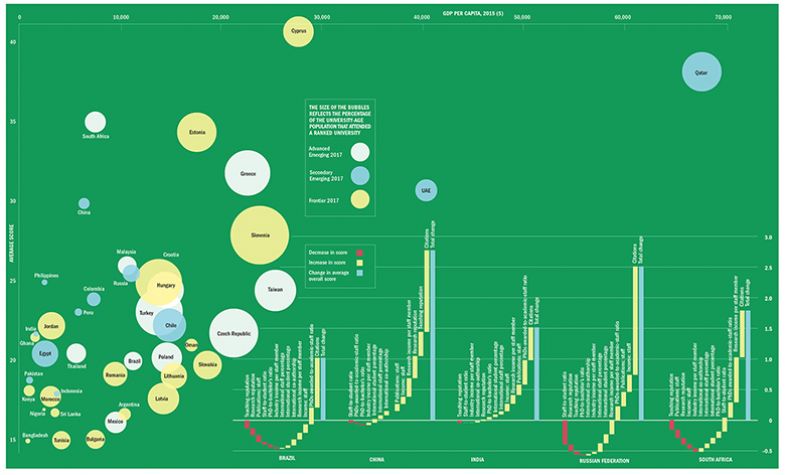Browse the 350+ list of institutions in this year’s rankings
The gap between China’s elite universities and the rest of its higher education sector is widening, according to the results of Times Higher Education’s latest ranking, suggesting that the country’s excellence initiative is already starting to have an effect.
China’s Peking University and Tsinghua University claim the top two places of the THE Emerging Economies University Rankings 2018 for the fifth year in a row. The country takes a further five places in the top 10 (one more than last year) and one in six – or 63 – positions in the table overall, up from 52 last year.
All of China’s 14 universities in the top 50 have either remained stable or risen. Harbin Institute of Technology, for instance, has climbed 12 places to 29th.
However, a different picture emerges lower down the table; 20 Chinese institutions, all of which are ranked below the top 50, have dropped places.
The results could be a consequence of the country’s Double World-Class Project, which has run since 2015 and focuses funding support on select universities and disciplines.
Indeed, all the Chinese institutions in the top 50 of the table and just eight of the 20 that have fallen are universities that the government promised last year to support to achieve “world-class” status.
– New name, wider frame
– Search our database of more than 3,000 global university jobs
– China’s haves and have-nots
It is also striking that the majority of the universities that lost ground in the rankings did so as a result of increased competition with other institutions in the country, while those that gained places generally achieved higher scores for teaching and research reputation this year.
Writing for THE’s Emerging Economies University Rankings supplement, Ka Ho Mok, vice-president and Lam Man Tsan chair professor of comparative policy at Lingnan University Hong Kong, says that in mainland China “preferential treatment of certain tiers of universities will inevitably intensify educational inequality”.
“If the Chinese government cannot properly address the widening gap between the ‘haves’ and ‘have-nots’, particularly the regional variations clearly revealed by the Double World-Class Project, with top university clusters located in Beijing, Shanghai and Nanjing areas, then the stratification process will unquestionably produce different social classes of students,” he writes.
He adds that students in China have also “begun to complain about a perceived decline in the quality of teaching”, given that institutions now “place far more importance on research and knowledge-transfer related activities”.
– A boon in Trump’s bombast
– The UAE’s oasis of knowledge
Jamil Salmi, former coordinator of the World Bank’s tertiary education programme and author of the book The Challenge of Establishing World-Class Universities, said that excellence initiatives “tend to exacerbate inequalities in resources” and noted that the beneficiaries of such programmes “have a clearer purpose of how they want to improve their performance”.
“By contrast, in countries where there is no excellence initiative per se, but where all public universities are equally well funded, we can see more homogeneity in ranking results,” he said.
A British Council report published last week also provided a warning about such schemes, claiming that emerging higher education systems in Southeast Asia could find that focusing on creating a handful of world-class universities may “come at the expense of the development of international research collaborations across the whole of the higher education systems”.
This year’s Emerging Economies University Rankings includes 378 universities, up from 300 last year. It uses the same 13 performance indicators as the THE World University Rankings, but they have been recalibrated to reflect the development priorities of universities in emerging economies.
ellie.bothwell@timeshighereducation.com
Emerging Economies University Rankings 2018: the top 10
| Emerging Economies University Ranking 2018 | Emerging Economies University Ranking 2017 | Position in World University Rankings 2018 | Institution | Country/region |
| 1 | 1 | =27 | Peking University | China |
| 2 | 2 | 30 | Tsinghua University | China |
| 3 | 3 | 194 | Lomonosov Moscow State University | Russian Federation |
| 4 | 6 | 116 | Fudan University | China |
| 5 | 5 | 132 | University of Science and Technology of China | China |
| 6 | 9 | =177 | Zhejiang University | China |
| 7 | 7 | =188 | Shanghai Jiao Tong University | China |
| 8 | 11 | =169 | Nanjing University | China |
| 9 | 4 | 171 | University of Cape Town | South Africa |
| 10 | 10 | =198 | National Taiwan University | Taiwan |
Browse the full list of institutions in this year’s rankings

Which universities are in with a chance of an upgrade?
A blend of state support and bespoke plans have boosted some institutions in emerging economies as rivals crop up close to home, writes Ellie Bothwell
The 2018 Times Higher Education Emerging Economies Rankings reveal a strikingly diverse set of institutions; universities from 42 countries and regions across four continents make the 350-plus list.
The institutions’ strengths and specialisms vary greatly, as do their histories; the top 20, for instance, features both Russia’s Lomonosov Moscow State University, a public research institution founded in 1755, and 25-year-old Koç University, a non-profit private university in Turkey.
But many institutions in the rankings also share a distinct characteristic: a drive and ambition to constantly evolve and improve. For many of the nations in the table, improving higher education will be key to their future development.
As Tod A. Laursen, interim president of Khalifa University of Science and Technology in the United Arab Emirates, writes in this supplement (see page 42): “There is indeed no reason why universities in emerging economies cannot drive change in the delivery of higher education in the future, and it is arguable that the best chances for true innovation will come from regions such as ours.”
Browse Times Higher Education’s portfolio of university rankings
One institution that has certainly evolved in recent years is Tomsk Polytechnic University in Russia. Its rector Petr Chubik highlights three significant changes. The university has “redirected” its research resources to advanced engineering fields where it already has “some background knowledge and experience”; introduced financial rewards for scholars who “show high performance in publications within highly ranked journals”; and increased cooperation with scientists from leading international research centres.
During the past five years, the university has also spent E40 million (£36 million) on new laboratory equipment; opened a science park, which unites leading international research centres and laboratories; and constructed a research nuclear reactor.
Meanwhile, two new research schools, in the areas of high-energy physics, and chemistry and applied biomedical sciences, aim to result in “breakthrough research activities and PhD training”, says Chubik.
Since 2013, the institution has also been part of Russia’s Project 5-100, a government programme that aims to establish five Russian universities in the world top 100 by 2020.
The result is that Tomsk Polytechnic University has leaped up the rankings; it is 21st in this year’s table, up from 56th in 2017, after a significant improvement in its citation impact score, and further rises in its scores for research environment, industry income and international outlook.
But Tomsk Polytechnic University is not the only institution that has significantly improved in this year’s table. Several others across a wide range of emerging economies have risen this year, largely because they have achieved higher citation impact scores.
View this year’s Emerging Economies University Rankings methodology
Although research quality can be a weak spot for some institutions in developing countries, it is the highest-weighted single metric in the table (20 per cent), so improvements in this area often have a significant impact on universities’ overall scores and ranking positions.
Masaryk University in the Czech Republic is one of these; it has risen 13 places to 83rd, primarily owing to boosts in its scores for research environment and research impact.
Petr Dvořák, its vice-rector for research, says that the development of “several narrow disciplines in the field of natural and medical sciences, which have in many cases started to work together on interdisciplinary themes”, has been the “most important” improvement for the institution.
In the past five years, the university has also worked hard to attract high-quality postdoctoral researchers, provide support for scientists in obtaining prestigious grants, and coordinate the purchase and use of costly equipment, he adds.
The American University in Cairo, which has risen 18 places to joint 120th, has also changed its approach to research.
The institution now tells its faculty “to focus more on the quality of publications rather than the quantity”, says its provost Ehab Abdel Rahman, and the quality of journals that researchers publish in is now one of the criteria for promotion.

Elsewhere in the Middle East and North Africa region, Qatar University has climbed 40 places to 35th.
Cesar Wazen, director of the university’s Scholarships and Partnerships Office, says that this improvement is mainly related to the fact that the university is “starting to get its return on Qatar’s investment in education and research”.
“The national research fund, established in 2006, allowed Qatar University researchers access to funds serving research on national priorities and our researchers constantly succeed in getting the highest number of awarded proposals among awarded institutes in Qatar. The fund itself encourages international collaboration,” he says.
Meanwhile, a number of state and industry funded chair positions that have been established in recent years in the fields of engineering, science and social science have varied and increased the investment in research at the university, he adds.
Download a copy of the Emerging Economies University Rankings 2018 digital supplement
Meanwhile, the University of Indonesia, which has climbed from the 201-250 band to joint 184th, has introduced a new remuneration scheme that “provides greater incentives” for faculty to publish their research in indexed scholarly journals. It even requires graduate students to publish their scientific papers in indexed and reputable journals as a condition for graduation.
The university has improved research collaborations with other national and international institutions and now holds 25 international conferences in the fields of health sciences, science and technology and social humanities to disseminate research and boost partnerships, adds its head of public relations, Rifelly Dewi Astuti.
The institution has also achieved a higher score for its international outlook, thanks to a new mobility programme for students and faculty, and a greater score for its teaching environment.
“The University of Indonesia continually changes the curriculum following the changes that occur in the professional world, with the aim of preparing graduates to become a professional workforce and have high competitiveness,” says Astuti.
Select universities in Brazil, Chile, Cyprus, India, Indonesia, Malaysia, Pakistan, the Philippines and South Africa have also made big gains.
But in many cases, the rise of these institutions bucks national trends; several countries in the rankings have suffered significant declines since last year.
For example, while Brazil has 32 representatives in the table, up from 25 last year, nearly all have declined, largely because of the country’s economic and political crisis. Its flagship, the University of São Paulo, is 14th – its lowest-ever position, marking the second year in a row that it sits outside the top 10.
It is a similar story elsewhere in Latin America, with Chile and Mexico also suffering declines, despite increasing their overall representation.
The majority of institutions in Taiwan, Turkey, the Czech Republic, Poland, Pakistan and Hungary have also fallen.
Even in China, several institutions have declined. Overall, 20 Chinese institutions – all of which are ranked below the top 50 – have dropped places.
In contrast, the 15 Chinese universities ranked between first and joint 51st place have all either remained stable or risen, suggesting that the gap between China’s elite universities and the rest of its higher education sector is widening.
As Ka Ho Mok, vice-president and Lam Man Tsan chair professor of comparative policy at Hong Kong’s Lingnan University, writes in this supplement (see page 36), China’s world-class university strategy will “inevitably intensify educational inequality”.
Indeed, all the institutions in the top 50 of the table and just eight of the 20 fallers are universities that the government announced it would support to achieve “world-class” status last year. It is also striking that the majority of the declining universities dropped owing to increased competition with other institutions in the country, while those that gained places generally achieved higher scores for teaching and research reputation this year.
As long as China continues to invest huge sums of money in its leading universities, it appears that its success in the rankings will continue in the years to come. The question is whether other emerging nations will manage to introduce similar strategies and successfully challenge the Asian giant’s dominance.
China pulls ahead
While higher education in emerging economies is generally developing at a rapid rate, the way China is still outstripping every other nation is clear from these “waterfall” charts (below).
The charts show the year-on-year change in each country’s average score in the ranking (the blue bar) and how changes in the 13 metrics that make up the overall score contribute to this.
China, whose universities now occupy seven of the top 10 places in the emerging economies ranking, has seen its average score shift almost three points, driven by a massive leap in citation performance. This is clearly now influencing its universities’ reputation too, while even on international metrics – where China struggles compared with other nations – it is improving.
Among other countries with a lot of institutions in the ranking, only Russia can compare with China for overall progress. Again, citations make up the bulk of its improved score but better research productivity, internationalisation and increased resources also contribute. However, its reputation scores appear to be falling back.
India too seems to have an issue with reputation preventing it from making more rapid progress.
Click on infographic to view hi-res version
In other emerging nations, there is much more of a mixture in score changes across the metrics. South Africa, whose overall change is comparable with India’s, is falling back on reputation, overall resources and productivity but improving on research quality and research income. Brazil, meanwhile, has more of a modest increase overall, mainly down to improvements in citation impact.
Meanwhile, a separate chart illustrates the correlation between average overall score and a country’s wealth. Qatar and the United Arab Emirates, the nations with the highest GDP per capita, are both among those with the best score, although there are some others that punch well above their weight (South Africa and China).
The size of the bubbles indicates the percentage of the university-age population that attend a ranked university, while the colours represent the three tiers of development for emerging nations – advanced, secondary and frontier – according to the FTSE categories.
Simon Baker, data editor
Watch our video of the 2018 results
Register to continue
Why register?
- Registration is free and only takes a moment
- Once registered, you can read 3 articles a month
- Sign up for our newsletter
Subscribe
Or subscribe for unlimited access to:
- Unlimited access to news, views, insights & reviews
- Digital editions
- Digital access to THE’s university and college rankings analysis
Already registered or a current subscriber?



